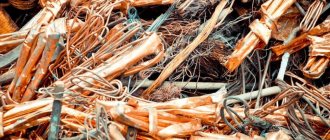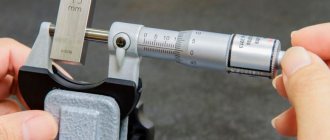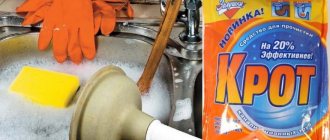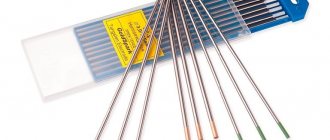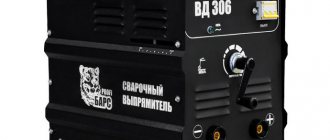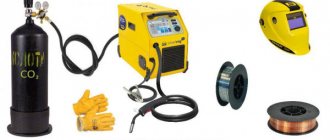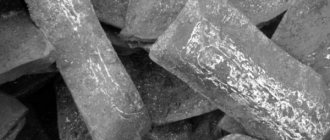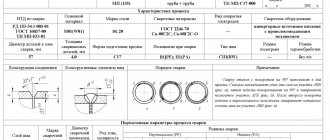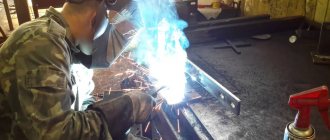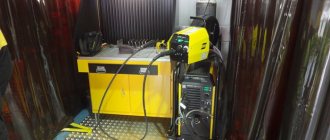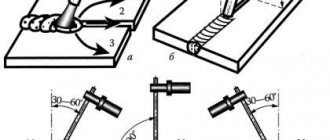When choosing electrodes, you also need to consider the presence of coating and its characteristics. This coating directly affects the durability and trouble-free subsequent operation of elements connected by welding. Coating the electrode helps protect the weld pool from the negative effects of external factors. The coating also ensures the maintenance of a stable temperature of the welding arc, which in turn has a positive effect on the quality of the connection. Special electrodes with coatings are widespread today, which allow welding on a rusty surface without any deterioration in the quality of the connection made.
Types of electrode coatings
The types of electrode coatings that are common today have unique properties and have their own marking designation.
Acid coated electrodes
Acidic coating. Such electrodes are marked with the letter A
. The basis of this coating is manganese, various iron oxides, silicon and other elements. It must be said that the main disadvantage of using such acid-coated electrodes is the risk of hot cracks appearing in the weld seam. Such cracks significantly deteriorate the quality of the resulting joint, and welding often has to be done again. Among the advantages of acid coating of electrodes, we can highlight the high resistance to the appearance of air channels in the seam, as well as the ability to weld rusty workpieces and parts with scale. This acid-coated surfacing material is widely used when welding with an arc of any length with alternating and direct current.
Cellulose coated electrodes
Cellulose coating. Electrodes with such coating are designated by the letter C
. A feature of surfacing rods with cellulose coating is the content of organic substances, the mass fraction of which in the composition can be 50%. Of these organic substances, cellulose is common, which allows for uniform formation of the weld bead of the welded material. Such electrodes have proven themselves to be excellent for vertical welding. The characteristics of the metal in the weld correspond to steel in a calm and semi-quiet state. It is only necessary to take into account that such welding electrodes contain a large amount of hydrogen, which, when working with steel, can significantly deteriorate the characteristics of the metal in the area of the weld.
Rutile coated electrodes
Rutile electrodes are marked with the letter P. As you can understand from the name, the coating contains a large amount of rutile with a small amount of oxygen and silicon. The presence of such additional elements can significantly reduce the likelihood of hot cracks forming in the weld. The resulting deposited material is characterized by increased impact strength. During welding, when a gas arc burns, gas is released, which helps protect the weld pool by forming organic compounds and carbonates on the surface. We only note that when welding is performed under conditions of high humidity and exposure to carbon dioxide, the quality of the joint can significantly deteriorate and signs of oxidation may appear. Therefore, it is necessary to carry out work in conditions of normal humidity and pre-calcinate the workpieces.
Such rods are sensitive to changes in welding conditions and temperature fluctuations in the seam. In such a case, even with a clean surface and the correct choice of the type of surfacing material used, a defective connection is possible. That is why it is necessary to withstand the conditions of welding work, which will ensure the quality of the connection. Experienced welders recommend initially piercing the materials being joined, which will avoid problems with oxidation of the connecting seam. Electrodes with rutile coating can be used in cases where pronounced traces of rust are visible on the surface of the metals being connected. Note that due to their ease of use, such rutile-coated electrodes are popular when performing welding work at home.
Electrodes with basic coating
Basic coating of electrodes. This coating is designated by the letter B. These rods are intended for manual arc welding and contain various minerals in the slag base. When welding with such electrodes, you should remember that a large amount of slag is formed during the work. Minerals emit gas that protects the hot and cooling weld from environmental influences. Among the advantages of such a base coating, we can note the low saturation with hydrogen, which eliminates the deterioration of the characteristics of steel and other metals. There is no hydrogen in the deposited material, which negatively affects the quality of the joint. The deposited metal is not prone to oxidation and has increased resistance to hydrogen sulfide cracking. Electrodes with basic coating due to their excellent characteristics can be used for welding pipelines.
Types of welding electrode coatings
There are 4 types of electrode coating for alternating current:
- Acidic is a mixture with a high content of iron and manganese, sometimes with titanium and silica. You can recognize them by the marking “A”. They can be used to cook raw metal, but the process releases many toxic substances.
- The main one is the most popular, marked as “B”. Such models can be used with alternating current, but with caution, since the ionization potential of the main coating is small.
- Rutile is the most suitable for working with “change”. Welding is easy, fast, there is no large spatter, the quality of the seam is good. You can recognize it by the “P” marking.
- Cellulose coating is more universal, suitable for both “change” and direct current. Marked as "C/S".
Electrode coating thickness and diameter
Electrode coating, regardless of its type, has unique properties that are manifested in the operation and physical characteristics of the resulting connections. Some of these unique properties include the following:
The combustion temperature of the coating does not affect the quality of welding, but the quality of arc ignition depends on this characteristic. Accordingly, the lower this characteristic, the better the arc lights up when welding begins.
The thickness of the coating largely depends on the diameter of the rod. In this case, there is a proportional relationship between the thickness of the electrode material and the thickness of the coating layer. As a rule, the coating makes up 30% of the total electrode thickness.
Certain types of coating differ in the degree of moisture absorption. The preparatory work that must be carried out before starting welding directly depends on this indicator.
Important. The existing coating on the electrode should not crumble or show signs of mechanical damage. It is not recommended to weld with such electrodes with damaged coating.
Purpose of coverage
The main task of the coating (the upper part of the electrode) is to protect the metal during welding. Oxidation that occurs when interacting with air negatively affects the quality of the compound. The seam becomes fragile. Cracks and pores can form in it, causing it to simply collapse.
The coating works this way. During welding, a slag shell forms on drops of electrode metal. When the arc moves along the molten surface, the seam is covered with a slag crust, protecting it from external influences.
The slag crust slows down the cooling of the metal and reduces the rate of its solidification. Due to this, destructive inclusions come out of it, reducing the strength of the seam. The protective coating of the rods consists of a large number of protective elements. The main components are titanium concentrate and kaolin.
Coating performs several very important functions:
- Protection of the arc and weld pool from oxygen, nitrogen and hydrogen present in the air. Protection consists of 2 levels. The first is carbon dioxide vapor, the second is carbon oxides covering the working area and slag formations.
- The coating promotes the formation of a seam without pores, cracks and slagged areas.
Among other equally important functions, it should be noted:
- Stable arc burning in various operating modes and simple ignition. Stability is achieved due to the presence in the coating of elements that are resistant to ionization in large volumes. As a result, the ions stabilize the arc.
- Thanks to ferroalloys, oxygen, which causes the formation of pores, is removed from the weld pool. Ferroalloys bind with oxygen and are released in the form of vapors.
- The coating helps clean the metal connection from excess impurities.
How to apply the coating
As mentioned above, the thickness of the coating directly depends on the diameter of the rod itself. Various technologies can be used to apply such a coating. Coating is applied during their manufacture using special equipment. Such equipment operates in a fully automatic mode, which improves the quality of coating on electrodes. Solid elements in the composition of the coating can be ground and additionally applied to the viscous base of the coating. To ensure a single fraction of such solid components, they are sifted through special filters, and only after that they are applied to the surface of the surfacing material. In some cases, when applying the coating, the finished composition is pre-fired, which makes it possible to remove sulfur, which can deteriorate the quality of the welded joint. At the last stage of coating, the machine dips the rods into the prepared mixture, and at the end we get a uniform layer of coating.
Additional types of electrodes
Consumables are divided into groups according to the method of operation.
Non-consumable electrodes
The products are designed for automatic and semi-automatic welding.
The following is supplied to the work area:
- protective gas (in most cases - argon);
- filler material.
Non-consumable electrodes are designed for automatic welding.
Refractory consumables do not have a coating.
They are made from the following materials:
- Tungsten. The metal is used in its pure form or with the addition of thorium, lanthanum, cerium, yttrium or zirconium. The type of additive is determined by color marking.
- Artificial pressed graphite.
- Electrical coal.
Non-melting consumables are used to cook:
- steel;
- cast iron;
- aluminum;
- copper;
- brass;
- bronze
When welding with a non-consumable electrode on direct current, the anode spot (on the “plus” side) has a higher temperature than the cathode spot.
Therefore, to connect thin-walled workpieces, reverse polarity is used: “+” is connected to the consumable. Otherwise, the metal will burn out.
Consumable electrodes
Products of this type are used in manual arc welding.
Consumable electrodes are used in manual arc welding.
During operation, the rod material is transferred to the weld pool.
Consumables are made from welding wire Sv-08 or Sv-08A.
The following types of steel are used (77 grades in total):
- carbon;
- alloyed;
- highly alloyed.
The product is selected in accordance with the material of the workpieces.
When welding with direct current, the cathode spot is hotter (on the “minus” side). Therefore, thin-walled workpieces are connected with direct polarity: “-” is connected to the consumable.
Electrodes made of non-ferrous metal
Such consumables are used for joining workpieces made of aluminum, copper, nickel, and other non-ferrous metals and their alloys. Select a rod from the same material as the parts to be welded.
The following brands are used:
- Aluminum – OZA-1 and OZA-2.
- Aluminum alloys – AF-4aKr and A-2.
- Copper, bronze, brass - MN-5, KM-100, AMNTs/LKZ-AB.
- Nickel and its alloys – KhN-1 or MZOK.
Non-ferrous metal electrodes are used for aluminum, copper, and nickel.
Electrodes for aluminum welding are made from Sv-A1 wire with a halide coating. They are suitable for all brands of metal.
Process parameters:
- D.C;
- reverse polarity;
- lower spatial position of the seam.
KM-100 consumables and similar ones are made of copper wire and equipped with a main coating (calcium fluoride). It is characterized by a reduced release of oxygen, which has a destructive effect on the metal. It is possible to combine copper with carbon steel.
Process parameters:
- D.C;
- reverse polarity;
- lower spatial position of the seam.
Electrodes for resistance welding are also made of copper or bronze.
Consumables of the MZOK brand and similar ones are made from nickel-copper wire with a basic type of coating.
Process parameters:
- D.C;
- direct and reverse polarity when welding;
- any spatial position of the seam.
Welding with electrodes with basic coating
When using electrodes with a basic coating for welding, several nuances need to be taken into account:
- Do not extend the welding arc. In this case, the metal is saturated with nitrogen, which significantly reduces the strength of the weld. May cause cracks.
- The working surface must be completely dry. Otherwise, pores may form in the seam.
- Mandatory requirements for storing electrodes must be observed. Store only in a dry place at a temperature not lower than 15°C. Some manufacturers pack electrodes in vacuum packaging. This significantly extends their shelf life without the need for re-calcination.
AC Electrode Brands
The most popular are domestic Tomsk, Losinoostrovsk and Moscow manufacturers:
- OZS-12 (SpetsElektrod, Moscow). Easy to apply a seam, insensitive to cracking, low and very affordable price. But he is afraid of dampness.
- Resanta MP-3. It ignites easily and burns stably at different arc lengths. Slag is separated easily and cleanly.
- Of the imported ones, the following are in good demand:
- ESAB-SVEL OK 46.00. They work very well even when wet. Quality and price go well together.
- Lincoln Electric Omnia 46. Small spattering, even rusty and uncleaned metal is easily “taken”. The seam is famous for its strength.
Correct selection of electrodes
The diameter of the electrodes used for welding must be selected taking into account the thickness of the workpieces. In this case, the composition of the surfacing and base material should be as similar as possible, which will allow for a uniform, strong connection. It is also necessary to take into account the melting temperature of the parts being connected, which must be the same. In the event that metal products with a thickness of 1-3 millimeters are welded, then two-millimeter electrodes and an operating current of the inverter from 25 to 100 Amperes can be used. If you are welding parts with a thickness of 3 to 6 millimeters, then electrodes with a thickness of 3-4 millimeters can be used. The optimal operating current is 150-200 Amperes. Welding surfacing materials with a diameter of more than six millimeters can be used to weld metal with a thickness of 10 centimeters or more.
Important. Before starting welding, you should evaluate the condition of the coating, which should not be damaged, which can significantly deteriorate the quality of the weld.
The length of the electrode is important in cases where it is undesirable to interrupt the welding process, which can lead to a deterioration in the quality of the work performed. For example, when repairing sealed containers for high-pressure pipelines, interrupting the welding process and using several rods to weld one joint can lead to a significant decrease in reliability. As a result, expensive and complex repairs will be required in the future. There are also certain metal alloys for which interruption of welding will invariably lead to deterioration in the quality of the joint. That is why, when choosing the length, it is necessary to proceed from the length of the weld and select the rods in such a way that their size is larger than the weld.
By choosing the right welding rods, taking into account their length and thickness, you can ensure a high-quality connection, while the resulting seam will have the necessary decorative effect, mechanical strength, durability and corrosion protection.
